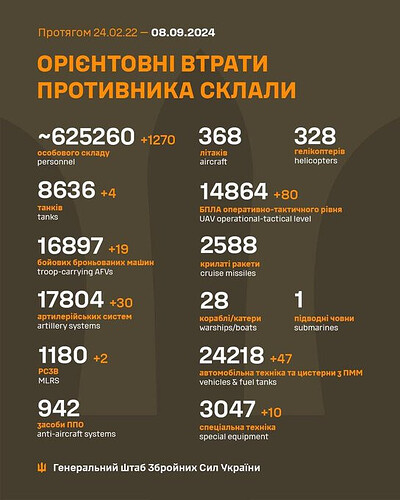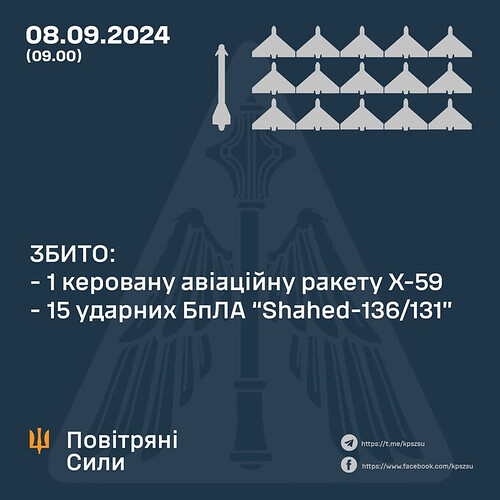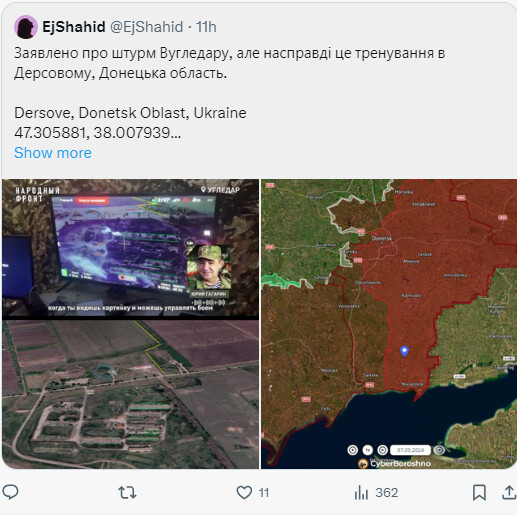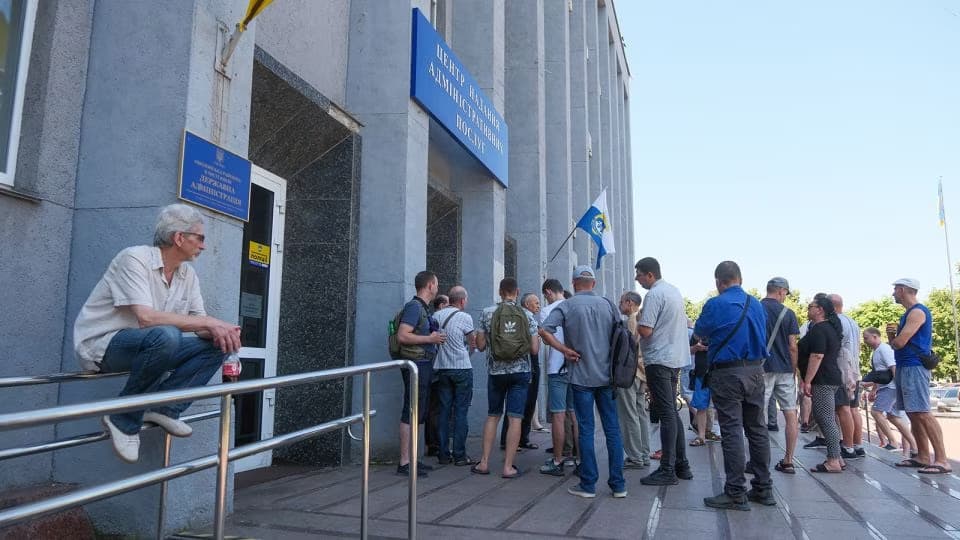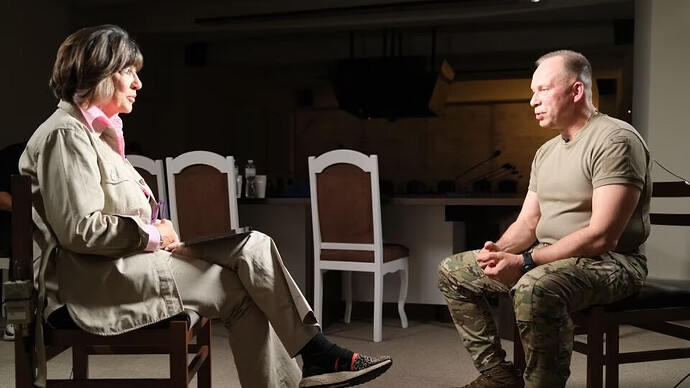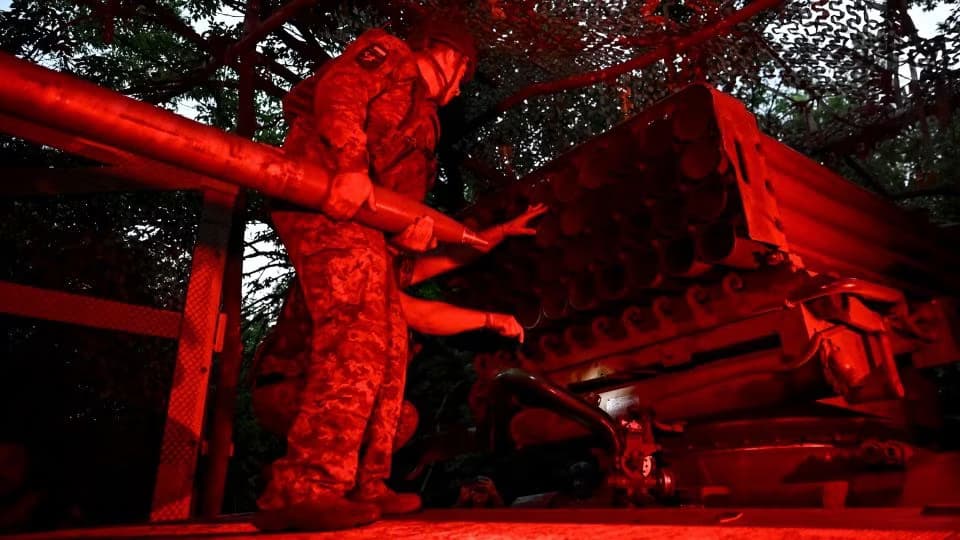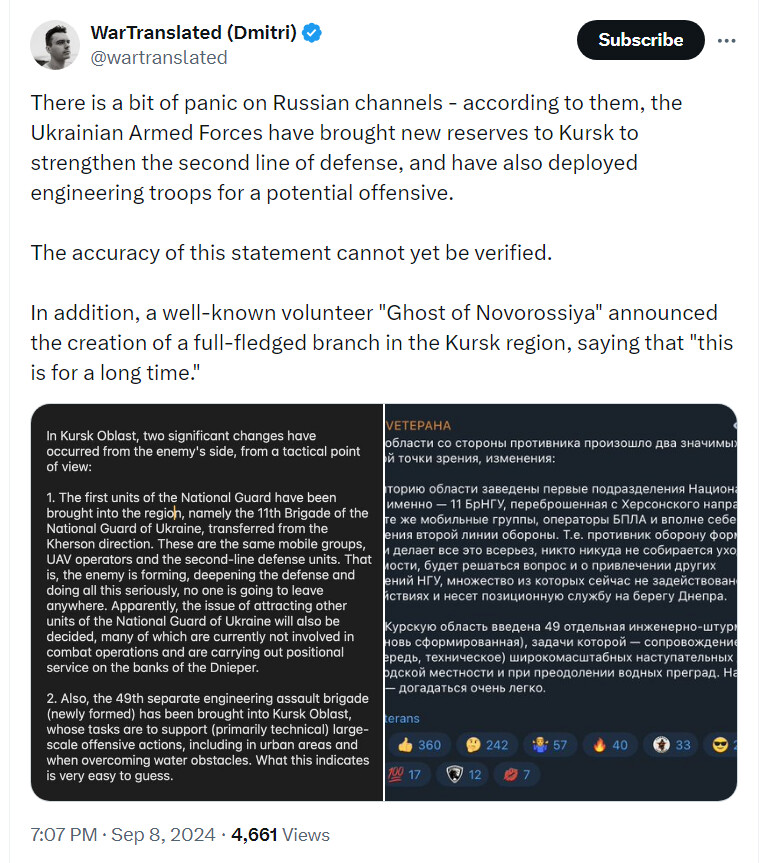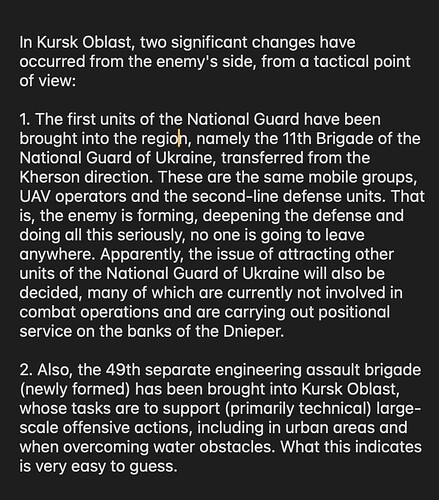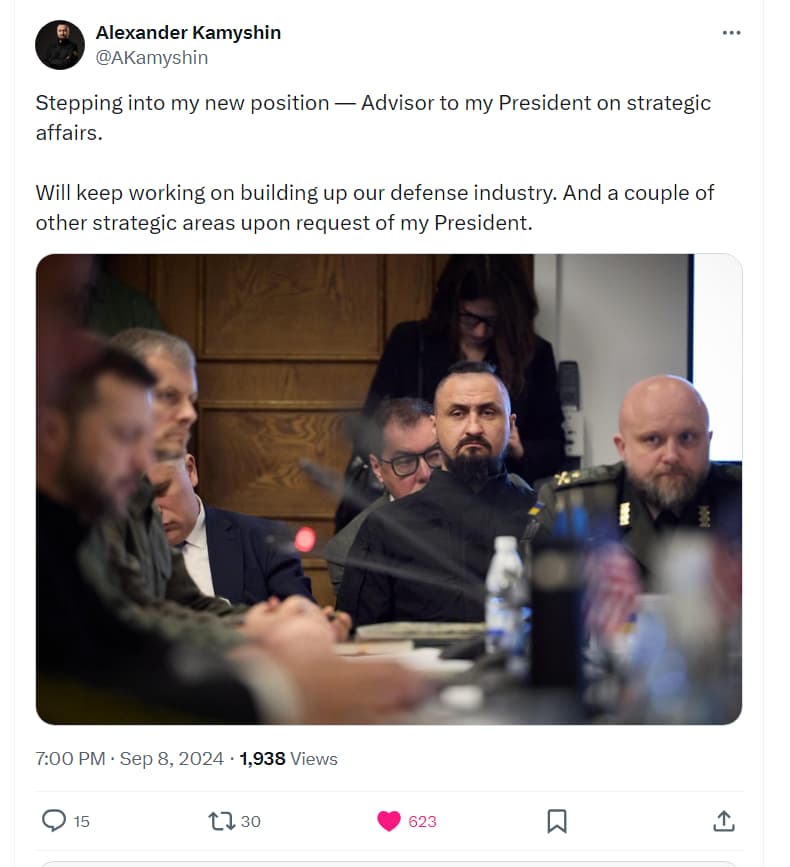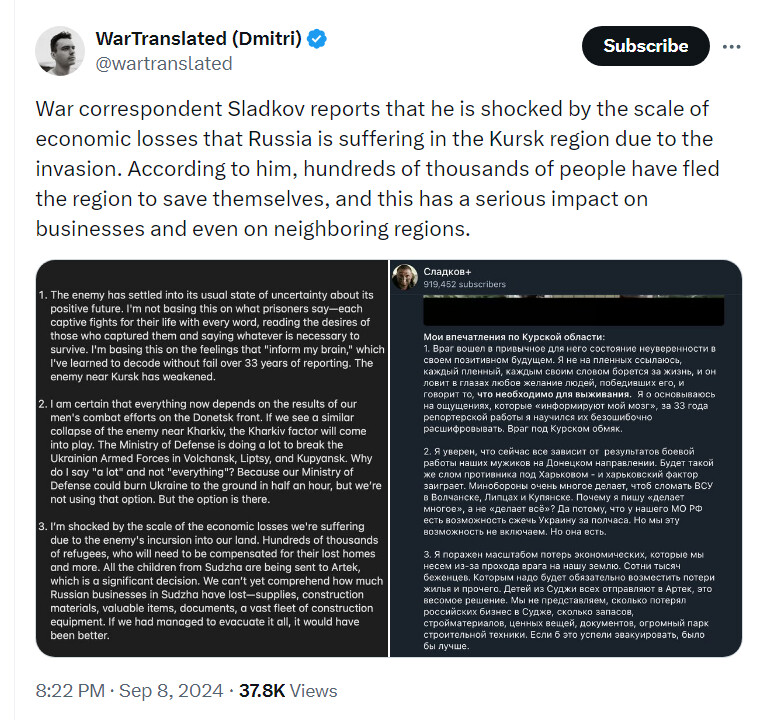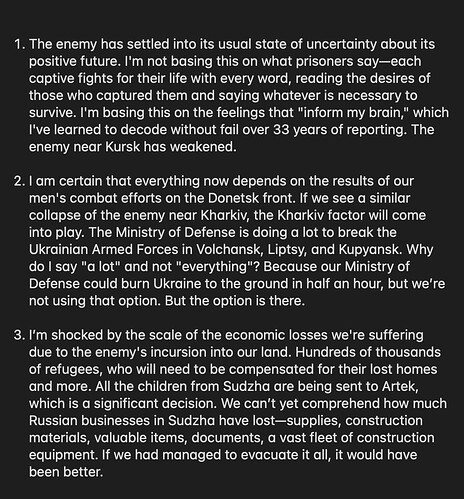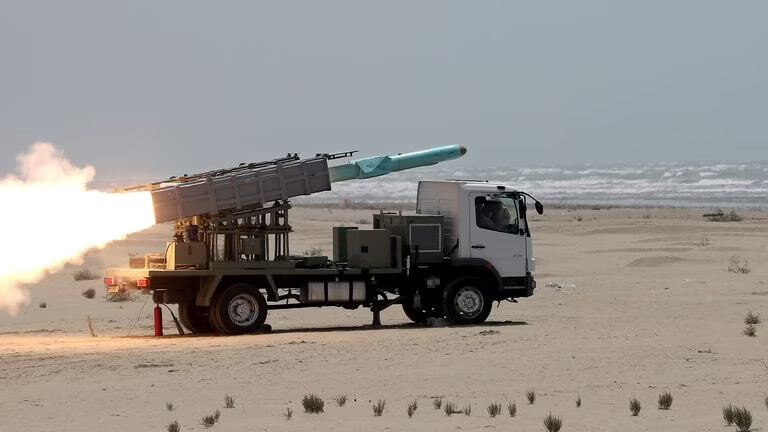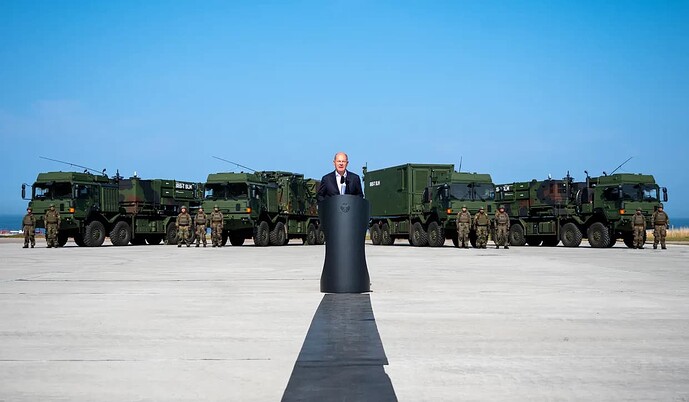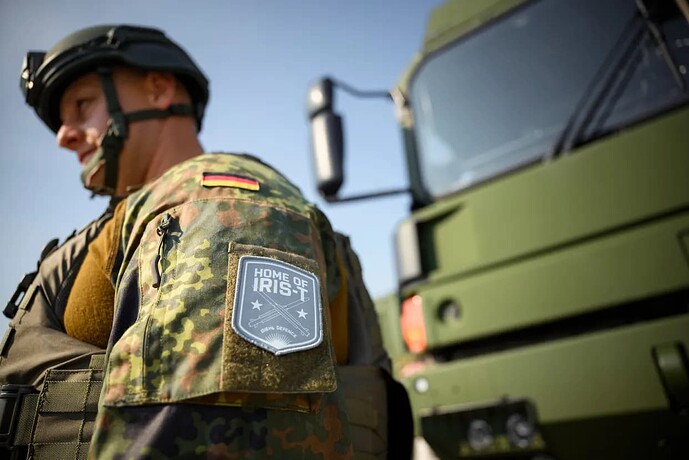I’ve somehow fallen into reverse world.
https://x.com/JayinKyiv/status/1832433896496963683
Timothy Snyder, loosely: Russia started the war with the premise that the idea of Ukranian nationalism was confined to only a few ‘elites’ in Ukraine and that if they killed / removed those people Ukraine would fold into Mother Russia neatly.
As that initial premise has been shown to be flawed the operation has turned into a genocide.
It’s the right time to search for a Russian bride, you young blokes.
Because Of Ukraine War And Kremlin’s Promotion Of Toxic Masculinity, Gender Gap In Population In Russia On The Rise – OpEd
September 8, 2024.
Because of war and other societal traumas in the Soviet Union, the share of men in the population of the Russian Federation is lower relative to women than in almost any other country and the gap between life expectancy of men and women there extremely high, Russian demographers say.
Between 2006 and 2021, these differences began to narrow; but with the launch of Putin’s expanded war in Ukraine and both the combat losses it has produced and the toxic masculine behaviors including increased alcohol consumption related to the war, both male-feel divisions have widened once again (cherta.media/story/strana-zhenshhin/).
In 2020, women formed 54 percent of the population of the Russian Federation, while men formed only 46 percent, demographers say; and they outlived men on average by 10 years. Now, new data show that the share of women in the population is rising, and the gap in life expectancy between the two genders is as well. Now, it is again over 11 years.
Many continue to blame these patterns on events of the 20th century, independent Moscow demographer Aleksey Raksha says; but that is a mistake. Today’s gender differences reflect both deaths from the war in Ukraine and even more, others say, riskier male behavior, including the over-consumption of hard liquor in the form of vodka or samogon.
Alcohol currently is behind “no fewer than 150,000 to 200,000 deaths in Russia each year, Raksha says, “and about 80 percent of them are men” who drink in response to the absence of the kind of possibilities that exist in other societies that encourage men in them to drink ever less and to worry more about taking care of their health.
Russian sociologist Irina Tartakovskaya says the shortage of men has enormous negative consequences for society, including but not limited to hostility toward women among men who can’t find sexual partners and the increasing number of female-headed single parent families who are poorer and a greater drain on state resources.
In Russia today, 4,850,000 families are in that category, “almost 40 percent of the total,” official statistics show (https://govoritmoskva.ru/news/406224); and their share will only increase if the gender gaps in Russia continue and the government does nothing to alter its current support for toxic masculinity.
But even if the war ends soon and the Russian government stops supporting risky male behaviors, Russian demographers like Raksha say, the likelihood that either of the gender gaps in Russian demography will change anytime in the next several decades is very low. Consequently, at least for the near future, the situation with regard to them and Russian society will get worse.
Russian losses per 08/09/24 reported by the Ukrainian General Staff
+1270 men
+4 tanks
+19 AFVs
+30 artillery systems
+2 MLRS
+80 UAVs
The Ukrainian Air Force reported on yet another missile/drone strike overnight.
Shot down
1/4 Kh-59/69 cruise missiles
15/23 Shahed drones
Additionally, two Shahed drones fell due to EW measures. The other three Kh-59/69 cruise missiles missed their target.
What the hell sort of contact mine is that?
A farked one obviously.
And what idiots would get near it, never mind roll it out of the ocean?
“The storming of Vugledar was announced, but in fact it was a training exercise in Dersovo, Donetsk region.”
Not pleasant reading, but it is what it is.
War, is hell.
Outgunned and outnumbered, Ukraine’s military is struggling with low morale and desertion
Published 12:01 AM EDT, Sun September 8, 2024
Pokrovsk, Sumy and Kyiv, UkraineCNN —
Dima never puts out a cigarette until he smokes it right down to the filter, risking burning his fingers to squeeze out one more drag. He spent years on the Ukrainian front lines. He knows the price of a good smoke.
As a battalion commander, Dima was in charge of around 800 men who fought in some of the fiercest, bloodiest battles of the war – most recently near Pokrovsk, the strategic eastern town that is now on the brink of falling to Russia.
But with most of his troops now dead or severely injured, Dima decided he’d had enough. He quit and took another job with the military – in an office in Kyiv.
Standing outside that office, chain smoking and drinking sweet coffee, he told CNN he just couldn’t handle watching his men die anymore.
Two and half years of Russia’s grinding offensive have decimated many Ukrainian units. Reinforcements are few and far between, leaving some soldiers exhausted and demoralized. The situation is particularly dire among infantry units near Pokrovsk and elsewhere on the eastern front line, where Ukraine is struggling to stop Russia’s creeping advances.
CNN spoke to six commanders and officers who are or were until recently fighting or supervising units in the area. All six said desertion and insubordination are becoming a widespread problem, especially among newly recruited soldiers.
Four of the six, including Dima, have asked for their names to be changed or withheld due to the sensitive nature of the topic and because they are not authorized to speak to the media.
“Not all mobilized soldiers are leaving their positions, but the majority are. When new guys come here, they see how difficult it is. They see a lot of enemy drones, artillery and mortars,” one unit commander currently fighting in Pokrovsk told CNN. He also asked to remain anonymous.
“They go to the positions once and if they survive, they never return. They either leave their positions, refuse to go into battle, or try to find a way to leave the army,” he added.
Unlike those who volunteered earlier in the war, many of the new recruits didn’t have a choice in entering the conflict. They were called up after Ukraine’s new mobilization law came into force in the spring and can’t leave legally until after the government introduces demobilization, unless they get special permission to do so.
Yet the discipline problems clearly began way before this. Ukraine went through an extremely difficult patch during last winter and spring. Months of delay in getting US military assistance into the country led to a critical ammunition shortage and a major slump in morale.
Multiple soldiers told CNN at the time that they would often find themselves in a good position, with a clear view of the approaching enemy and no artillery rounds to fire. Some spoke of feeling guilty for not being able to provide adequate cover for their infantry units.
“The days are long, they live in a dugout, on duty around the clock and if they can’t shoot, the Russians have an advantage, they hear them advancing and they know that if they had fired it wouldn’t have happened,” said Andryi Horetskyi, a Ukrainian military officer whose unit is now fighting in Chasiv Yar, another eastern frontline hot spot.
Serhiy Tsehotskiy, an officer with the 59th Separate Motorized Infantry Brigade, told CNN the unit tries to rotate soldiers in and out every three to four days. But drones, which have only increased in number over the course of the war, can make that too dangerous, forcing soldiers to stay put for longer. “The record is 20 days,” he said.
As the battlefield situation deteriorated, an increasing number of troops started to give up. In just the first four months of 2024, prosecutors launched criminal proceedings against almost 19,000 soldiers who either abandoned their posts or deserted, according to the Ukrainian parliament. More than a million Ukrainians serve in the country’s defense and security forces, although this number includes everyone, including people working in offices far away from the front lines.
It’s a staggering and – most likely – incomplete number. Several commanders told CNN that many officers would not report desertion and unauthorized absences, hoping instead to convince troops to return voluntarily, without facing punishment.
This approach became so common that Ukraine changed the law to decriminalize desertion and absence without leave, if committed for the first time.
Horetskyi told CNN that this move made sense. “Threats will only make things worse. A smart commander will delay threats, or even avoid them,” he said.
Pokrovsk has become the epicenter of the fight for Ukraine’s east. Russian forces have been inching towards the city for months, but their advances have sped up in recent weeks as Ukrainian defenses begin to crumble.
'Everything feels the same’
Russian President Vladimir Putin has made it clear his goal is to gain control over the entirety of Ukraine’s Donetsk and Luhansk regions and taking over Pokrovsk, an important military and supply hub, would be a major step towards that objective.
It sits on a key road that connects it to other military cities in the area and a railroad that links it with Dnipro. The last major coking coal mine still under Kyiv’s control is also just to the west of the city, supplying coke to make steel – an indispensable wartime resource.
Ukrainian soldiers in the area paint a grim picture of the situation. Kyiv’s forces are clearly outnumbered and outgunned, with some commanders estimating there are 10 Russian soldiers to each Ukrainian.
But they also appear to be struggling with problems of their own making.
An officer from a brigade fighting in Pokrovsk, who asked for their name to be withheld for security reasons, told CNN that poor communication between different units is a major issue there.
There have even been cases of troops not disclosing the full battlefield picture to other units out of fear it would make them look bad, the officer said.
One battalion commander in northern Donetsk said his flank was recently left exposed to Russian attacks after soldiers from neighboring units abandoned their positions without reporting it.
The high number of different units that Kyiv has sent to the eastern front lines has caused communication problems, according to several rank-and-file soldiers who were until recently fighting in Pokrovsk.
One said it was not unheard of to have Ukrainian signal jammers affecting vital coordination and drone launches because units from different brigades didn’t communicate properly.
A group of sappers – or combat engineers – spoke to CNN near the border between Ukraine and Russia’s Kursk region, where they have been recently redeployed from just south of Pokrovsk.
Kyiv launched its surprise incursion into Kursk last month, taking Moscow by surprise and quickly advancing some 30 kilometers (19 miles) into Russian territory.
Ukraine’s leaders, including President Volodymyr Zelensky, said one of the goals of the operation was to prevent further attacks on northern Ukraine, while also showing Kyiv’s Western allies that, with the right support, the Ukrainian military can fight back and eventually win the war.
The operation also gave a major boost to an exhausted nation. Ukraine has been on the backfoot for most of the past year, enduring relentless attacks, blackouts and heartbreaking losses.
But the sappers were not too sure about the strategy. Having just finished a long mission over the border, they were slumped around a table outside a closed restaurant near the frontier, waiting for their car to turn up.
Chain smoking and trying to stay awake, they questioned why they were sent to Kursk when the eastern front line is in disarray.
“It felt weird entering Russia, because in this war we were supposed to defend our soil and our country, and now we’re fighting on the other country’s territory,” one of them said. CNN is not disclosing their identities because they were not authorized to speak to the media and due to the sensitive nature of their words.
All four have been fighting for more than two-and-half years and theirs is a tough job. As sappers, they spend days on the front lines, clearing mine fields, preparing defenses and conducting controlled explosions. They can find themselves under attack, ahead of even the first line of infantry, dragging around some 40 kilograms (88 pounds) of kit and four anti-tank mines, each weighing about 10 kilograms (22 pounds).
Speaking to CNN, they appeared completely exhausted. They had no rest between their Pokrovsk mission and the one in Kursk.
"It depends on each commander. Some units receive rotations and have time off, while others are just fighting non-stop, the whole system is not very fair,” one of the soldiers said. Asked if the advances in Kursk gave them the same boost as the rest of the nation, they remained skeptical.
“After three years of this, war, everything feels the same,” one of the men told CNN.
‘Rotten approach’
Speaking to CNN on Thursday, Ukraine’s Commander in Chief Oleksandr Syrskyi admitted low morale is still an issue and said raising it was “a very important part” of his job.
“The Kursk operation… significantly improved the morale of not only the military but the entire Ukrainian population,” he said.
He said he had been going to the front lines regularly to meet with the soldiers there and do what he could to make them feel better. “We understand each other no matter who I am talking to, whether it is an ordinary soldier, a rifleman, for example, or a brigade commander or a battalion commander… I know all the problems that our servicemen, soldiers, and officers experience. The front line is my life,” he said.
And Horetskyi – an officer specially trained to provide moral and psychological support to troops – is part of the plan to boost morale.
During recent leave in Kyiv, Horetskyi told CNN that while his role has existed for a while, it consisted mostly of paperwork. Now he spends a lot more time with his unit, checking in, making sure they are not burning out. Not that his help is always appreciated.
“They have this idea that I’m a shrink that will make them take thousands of tests and then tell them they are sick, so I try to break down the barriers,” he said, adding that little distractions can prevent a downward spiral.
In the monotony of war, any break from the routine can help, he said. This can include a wash in a real shower, a haircut or going for a swim in a lake. “It’s such a little thing, but it gets them out of the routine for half a day, it makes them happy, and they can return to their positions a bit more relaxed,” Horetskyi explained.
Even officers with many years of experience are finding the situation in the east difficult.
Some, like Dima, are transferring to posts away from the front lines. He said his decision to leave the battlefield was mostly down to disagreements with a new commander.
That, too, is increasingly common, several officers told CNN.
The ranks of Dima’s battalion grew thinner and thinner, until the unit disappeared.
They never received enough reinforcements, Dima says, something he blames squarely on the government and its reluctance to recruit more people.
The battalion suffered painful losses in the past year, fighting on multiple front lines before being sent to Pokrovsk without any rest. Dima saw so many of his men killed and wounded, he became numb.
Yet he told CNN he is determined to go back to the front lines, but will make one change first.
“I’ve now made the decision that I will stop getting attached to people emotionally. It’s a rotten approach, but it’s the most sensible one,” he said.
They’re going to push across The Volga, I’m hoping.
Not ideal, but I imagine the other side’s morale issues are worse.
Russia’s links with Iran are growing stronger - and Ukraine and the West will have to retaliate
Western allies may retaliate with sanctions if Iran has provided Russia with ballistic weapons - and it could also convince them to relax restrictions preventing Ukraine from using long-range missiles inside Russia.
Sunday 8 September 2024 11:52, UK
The head of the CIA has warned that any move by Iran to supply Russia with ballistic missiles for its war in Ukraine would be a “dramatic escalation” - but Ukrainian sources say this has already happened.
It is part of a pattern of ever-tighter cooperation between Moscow and Tehran, which has already seen the Iranian regime transfer huge quantities of killer drones, ammunition and artillery shells in return for cash and help from Russia on improving its own military technology and manufacturing capabilities.
This includes the alleged gifting by the Kremlin to Iran of captured Western weapons, such as the N-LAW anti-tank missile.
“It is a two-way street,” Bill Burns, the CIA director, said in his first public appearance with his British counterpart, Sir Richard Moore, at an event in London at the weekend.
“Russia is able to do a number of things to help Iran’s ballistic missiles - to make them more dangerous to use against our friends and partners across the Middle East.”
Western officials have long been warning about the potential for Iran to start supplying ballistic missiles to Russia.
Grant Shapps, when he was defence secretary, signalled in an interview with House Magazine in March, that a transfer had already happened after the Reuters news agency reported that around 400 such munitions had been transferred.
Then on Saturday, multiple news organisations - including Sky News, citing a Ukrainian source - reported that Iran had supplied Russia with more than 200 short-range, Fatah-360 ballistic missiles.
Iran has yet to comment and has in the past denied the allegations.
The regime had previously held off from offering up its vast stockpiles of precision-guided missiles, amid the threat of further Western sanctions and international isolation.
However, its calculations appear to have changed following the expiry last October of UN Security Council sanctions designed to curb Iran’s ballistic missile programme as part of a major 2015 nuclear agreement with world powers that has since unravelled.
‘Impossible to hide’ missile sales
Sir Richard Moore, the head of MI6, speaking alongside Mr Burns, signalled if Iran has started supplying ballistic missiles to Russia then it would be impossible to hide once used.
“If stuff comes on the battlefield, it will become very obvious, very quickly,” he said.
“It explodes, it kills Ukrainian civilians, it destroys their infrastructure and… you have to remind yourself this is what Iran is choosing to do. It is choosing to help Russia to do these types of things.”
It is not just Iran, North Korea has also bolstered shrinking Russian stockpiles with missiles and ammunition to be used in Ukraine.
China is another ally - with the power to provide potentially game-changing support.
Some small comforts to help the evacuees going into internal exile in Uraine away from the combat zones. The last train from Pokrovsk was equiped with pet carriers, toiletry bags and sanitisers for the passengers…
While the West warns Iran and condemns it as a pariah State, Iran develops closer relations wth other Middle Eastern countries regarded as friends of the West.
The new Iran President is to visit Iraq to sign a bilateral cooperation and security agreement.
17 IRIS-Ts will boost Ukraine’s air defenses but it’s still not enough, experts say
September 8, 2024 4:50 PM
Ukraine’s continued requests to Western allies for more air defenses were answered in part this week, with the announcement that Germany has ordered an additional 17 IRIS-T air defense systems for Kyiv.
And the timing couldn’t be more critical – an ongoing campaign of aerial strikes on Kharkiv, devastating attacks like that on Ukraine’s largest children’s hospital in July, a strike on Poltava earlier this week that killed at least 55 people, and an attack on Lviv the day after, repeatedly highlight the shortcomings in the country’s air defenses.
“Russia continues to wage a cowardly war against civilians, which constitutes war crimes.” President Volodymyr Zelensky wrote on X, reacting to the biggest Russian mass attack across Ukraine that killed seven people and injured nearly 50 on Aug. 26, using a total of 236 missiles and drones.
Berlin launched an initiative to bolster Ukraine’s air defense in April, and has become one of Ukraine’s leading suppliers of systems.
“This shows that German support for Ukraine is not letting up,” German Chancellor Olaf Scholz said on Sept. 4 when announcing the latest batch of 17 IRIS-Ts.
According to Scholz, Ukraine already has seven which have been used to shoot down more than 250 Russian missiles and drones.
But according to experts who spoke to the Kyiv Independent, while welcome, the IRIS-Ts will be unable to protect from something that has become an increasing concern in recent days – Iranian ballistic missiles.
What do we know about the IRIS-T?
By 2026, Ukraine should have received 24 IRIS-T systems from Germany — 12 of medium-range versions, IRIS-T SLM, and 12 short-range, IRIS-T SLS — according to Bloomberg.
“The numbers are significant,” Fabian Hoffmann, a doctoral research fellow at the University of Oslo who specializes in missile technology, told the Kyiv Independent, adding it will be more than Germany or any other country deploys.
“Ukraine will probably be the largest operator of IRIS-T SLM for a while,” he added.
The short-range system can hit a target at a distance of 12 km (8 miles) and at an altitude of up to 8 km (4 miles), while the medium-range system can reach targets at 40 km (24 miles) and at an altitude of 20 km (13 miles).
The IRIS-T launchers, which can carry eight missiles, are portable and can be transported on tracked platforms or trucks made by its German manufacturer, Diehl Defense.
“One of the IRIS-T’s advantages is its mobility, which improves survivability,” Hoffman said.
The missiles – which can reach a speed of around Mach 3 (1,020 meters per second) – are launched vertically, meaning there are no blind spots directly above the system.
They are equipped with a controlled thrust vector system that improves maneuverability, and an infrared guidance system that responds to heat radiated by the target (IRIS-T stands for “infrared imaging system tail/thrust vector-controlled.”)
The missile is also capable of detecting heat traps, which Russia has equipped some cruise missiles with in order to make them harder to intercept.
Hoffmann highlighted the TRML 4D air surveillance radar used for the IRIS-T air defense system, which performs well including in so-called “cluttered environments.”
“If you scan for something like cruise missiles or drones that fly fairly close to the ground, there will be trees, mountains, many buildings in the way, and you have to filter those out to discriminate the actual threat,” Hoffmann said.
“The TRML is long-range with a great ability to filter out that clutter and a good ability to track incoming targets and then guide the interceptor to it,” he added.
However, this radar, like the system itself, is not so effective against some of the weapons used by Russia in its attacks against Ukraine.
What air targets can't IRIS-T shoot down?
The German-made system is optimized to defend against low-flying subsonic and low radar cross-section targets like cruise missiles, but it is not capable of intercepting a ballistic missile, according to experts.
And in most of its mass attacks, Russia has the highest success rate with ballistic missiles, John Hardie, deputy director of the Russia Program at the Foundation for Defense of Democracies, told the Kyiv Independent, adding that Ukraine so far relies mainly on the U.S.-made Patriot air defense system, to protect itself from such threats.
Ballistic missiles such as the Russian Iskander M or Kinzhal approach from a high altitude — up to 50 kilometers (31 miles) and 20 kilometers (12 miles) respectively — and then descend at high speed, up to 3,200 kilometers per hour.
“If you want to take down a ballistic missile, you also need to incorporate some type of terminal guidance, so the interceptor can autonomously or independently course correct over the last couple of meters,” Hoffmann said.
“Again, that’s not given with IRIS-T, which is why they will not really be able to defend against ballistic missiles,” he added.
The increased ballistic threat
While Russia has regularly fired its own ballistic missiles such as the Iskander and the Kinzhal against Ukrainian cities since the start of the full-scale invasion, recent news reports suggest the use of such weapons could soon increase.
According to the Wall Street Journal (WSJ) on Sept. 6, Iran has sent an unknown number of short-range ballistic missiles to Russia, a move the U.S. has described as a “dramatic escalation” in Tehran’s support for Moscow’s full-scale war against Ukraine.
“These more strategic weapons would basically suck up interceptor missiles, and when it comes to defending against ballistic missiles, you can only use certain systems,” Fabian Hinz, a research fellow for defense and military analysis at the International Institute for Strategic Studies, told the Kyiv Independent for a previous article.
“Ukraine has the Patriot air defense system, but the numbers of interceptors are limited so that could potentially be a challenge if you have large numbers of Iranian missiles.”
So despite arriving in significant numbers, the IRIS-T system would not be effective in dealing with an increased threat from Iranian ballistic missiles.
But they will still be useful – the system can effectively shoot down low-flying targets, such as aircraft, helicopters, cruise missiles, and drones, which Russia also frequently uses to attack Ukraine.
In August alone, Ukraine’s Ground Forces shot down five airplanes, two helicopters, 1,539 drones, and 150 missiles, according to Oleksandr Pavliuk, Ukraine’s Ground Forces commander.
“These systems are important for augmenting Ukrainian air defense, particularly given Ukraine’s shortage of interceptors for its Soviet-made systems,” Hardie said.
However, despite their effectiveness against low-flying targets and increase in supplies from allied countries, the number of IRIS-Ts is still insufficient for Ukraine’s needs.
“The numbers (of German supply) are rather significant, at least compared to what other countries currently deploy or plan to deploy,” Hoffman said.
“Unfortunately, that still does not mean it is enough in the Ukrainian context.”
One can only hope this eventuates.
For sure, the best way to topple a government is to affect the wealth of the rich.
Putin in danger of being toppled by fretful oligarchs as Ukraine war wipes out riches
Sanctioned oligarchs could get rid of Vladimir Putin if their fortunes run out, a former US Army Commander has suggested.
15:13, Sun, Sep 8, 2024 | UPDATED: 15:14, Sun, Sep 8, 2024
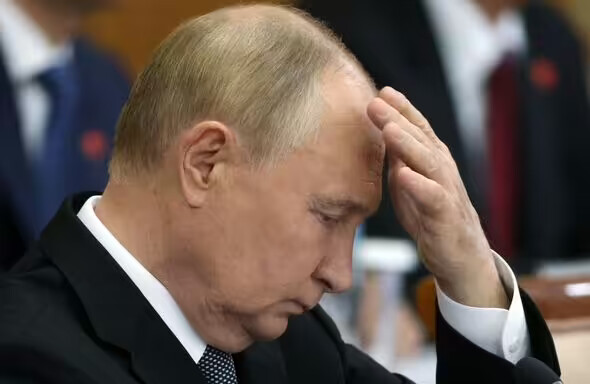
Russian oligarchs are feeling fretful about Vladimir Putin’s war in Ukraine, a US general says (Image: Getty
Lt General Ben Hodges, an ex US Army commander, said the rich Russians who support Russia’s president could turn on the autocrat if the war in Ukraine rages on.
Wealthy Russian oligarchs were hit with sanctions by Ukraine’s western allies as a consequence of Russia’s full scale invasion of its neighbour in February 2022.
Assets were frozen and travel bans imposed on them, with Mr Hodges saying the sanctions could prove pivotal in toppling Putin from power.
He told The Sun at some point the oligarchs have to get tired of the restrictions imposed on them and their fortunes.
The ex-Army commander added: “At some point, they will say, ‘I can’t go see my mistress on the Adriatic. I can’t send my kids to school in London anymore or Stanford’. Then I think potentially something happens.”
Mr Hodges urged Ukraine’s allies to isolate Russia diplomatically, economically, politically and militarily from the rest of the world.
The European Union (EU) has sanctioned Putin, his Foreign Minister Sergei Lavrov, former president of Ukraine Viktor Yanukovych and former Chelsea owner Roman Abramovich.
Besides oligarchs, sanctions have been imposed by the West on members of Russia’s state Duma, its National Security Council and pro-Kremlin propagandists.
While some experts have suggested oligarchs can bring Putin down, others suggest they are more or less powerless, pointing in part to a televised meeting the Russian leader held with top industrialists straight after the war widened in which he told them he had no choice but to invade.
Associated Press analysis reports that despite the hit to their pockets as a result of the war, most of Russia’s ultra-wealthy have kept quiet about the conflict or offered token criticism.
It points to banking and brewing entrepreneur Oleg Tinkov as a rare exception. He denounced the war and called those who support it “morons”. He left the country in late 2022 and later renounced his citizenship.
Analyst Alexandra Prokopenko has written previously: “Even as the elites grumble, they continue to show loyalty.”
She and others have suggested Putin wants to create a new cadre of hugely wealthy figures beholden to him.
He reportedly wants to do so by distributing assets Russia seized from foreign companies exiting the country and by invalidating privatisations carried out in the 1990s.
Analyst Nikolai Petrov of the Royal Institute of International Affairs wrote Russia is engaged in deprivatisation aimed at redistributing wealth to a new generation of “less-powerful individuals” in a bid to shore up Putin’s own position.

